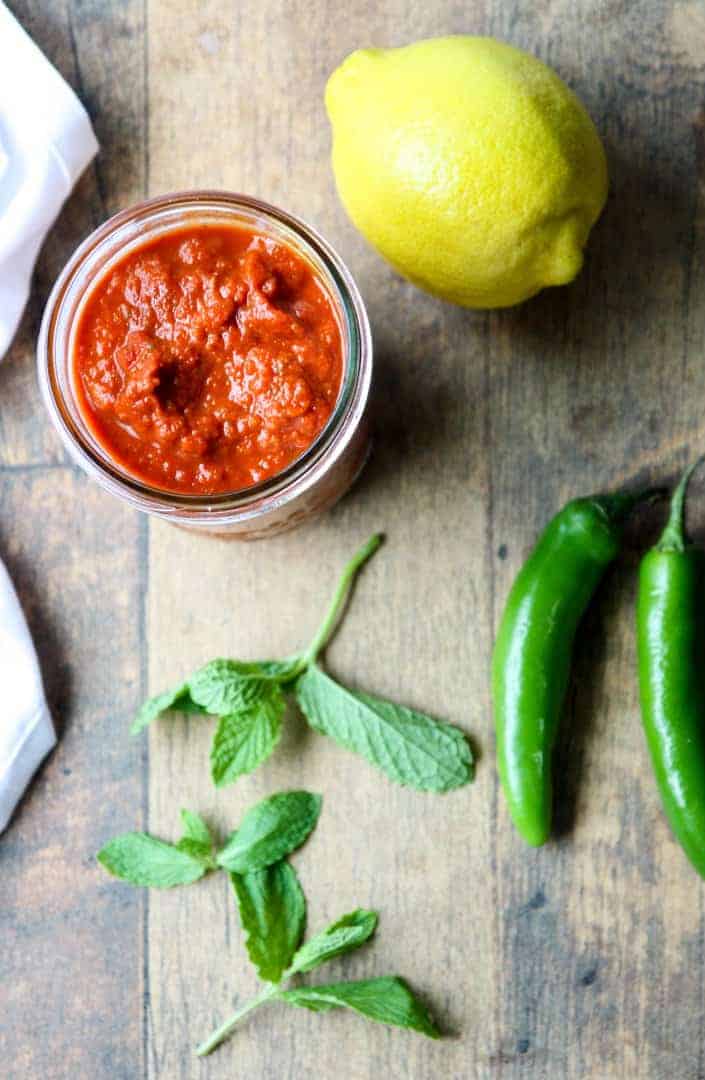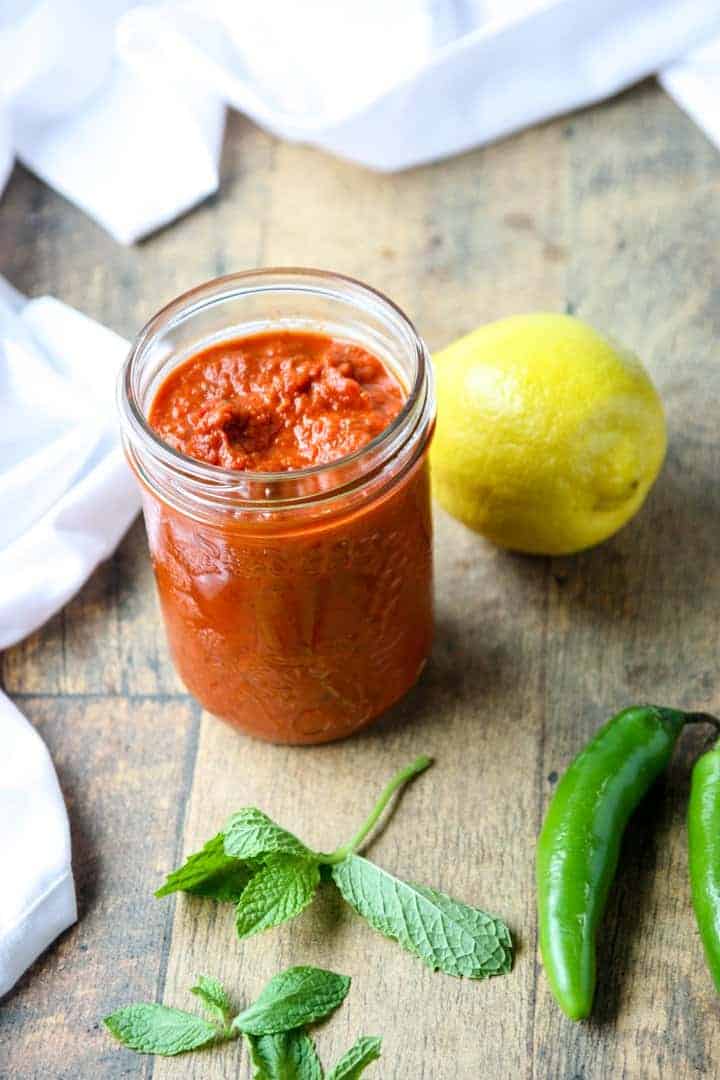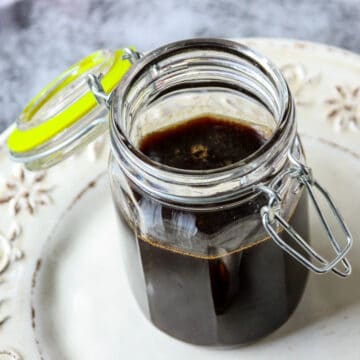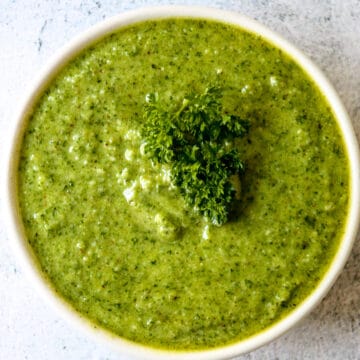Harissa Paste is one of those condiments that you can so easily make yourself. And the results are much more delicious than anything you can find in the store.

Want to save this recipe?
Enter your email & I'll send it to your inbox. Plus, get great new recipes from me every week!
What is Harissa?
Harissa is a roasted pepper chile paste that originated in Tunisia but is also a popular condiment in other North African countries, like Morocco, Algeria, and Lybia. Recipes for the spicy condiment vary amongst areas and households. However, they are all based on chile peppers, usually roasted.

What Type of Chiles to Use
You can use any type of chile or a mixture of chiles for Harissa. Some of them should be red ones because this is a red sauce. And some of them should be spicy because this is a hot sauce. I used sweet red bell pepper and some serrano peppers in this recipe, but here are some suggestions for both sweet and hot peppers:
Sweet Peppers
- Bell Peppers (Any colour)
- Pimento Peppers
- Cubanelle Peppers
- Italian Frying Peppers
- Cherry Peppers
Hot Peppers
- Aleppo Peppers
- Jalapeno Peppers
- Poblano Peppers
- Anaheim Peppers
- Hungarian Wax Peppers

Using Fresh Chiles vs Dried Chiles
You will often see Harissa recipes that use dried chilies. Both the dried chile and the fresh chile versions work and there are, as mentioned, many variations of them both. A fresh chile base will have a different flavour and texture than a dried chile based paste.
The fresh chile version is lighter, with a less intense, but fresh flavour and a looser texture. This makes it perfect for marinades and as a condiment, anywhere it will stand on its own rather than as a flavour add-in.
Dried chilies give the paste a deeper, more intense flavour, and a denser texture, making this paste ideal for adding to sauces, soups, and stews.
All of that being said, the two versions are interchangeable in any recipe.

How Spicy Is Harissa Paste?
Harissa can be as spicy, or not, as you like. It does need to have some heat in order to be harissa, but the actual heat level is up to the cook. The spice level will depend on the types of chiles that you use. Although I made some pepper suggestions above, there are literally thousands of pepper varieties. They fall into a huge range of heat levels that are scored by Scoville units. If you want to know more about that, and also choose your peppers based on their heat levels, check out this explanation of the measurement, and a handy chart: The Scoville Scale
Other factors affecting the spice level are the proportions of hot vs sweet peppers, and the addition of any other spices used.
It also depends on who will be eating! Different people have different spice tolerances, which is something to keep in mind whenever you're serving spicy dishes.
This particular recipe has a fairly mild spice level in order to appeal to some not so spice tolerant people at our table.

How Long Will The Paste Keep?
You can keep your homemade paste in a jar in the fridge for up to two weeks, or you can freeze it for up to a month.
How To Use Harissa Paste
- Anywhere that you would use a hot sauce (like Sriracha, or Cayenne Pepper Sauce), you can use harissa paste.
- Try it on scrambled, fried or poached eggs.
- Add a drizzle to soup, like this Moroccan Sweet Potato Soup with Chickpeas
- Put in on Burgers, Wraps & Sandwiches
- Try it for grilling: Grilled Harissa Chicken Drumsticks
- Add some spice to hummus or Muhammara (another delicious dip)
- Use in stews like Moroccan Chicken & Lentils Tagine
- It's also delicious in these Moroccan Chicken Stuffed Peppers
Spices Used In This Recipe
Although I have included measurements for ground spices, I like to use whole spices whenever possible. Whole spices have a much longer shelf life, while the flavours of ground spices will probably fade before you can use them up. Besides the spices in this recipe, here is a handy guide from Food 52 for the measurements to convert other spices from whole to ground: Spice Conversions Whole to Ground
To grind your own spices, you can use a spice grinder if you have one. Or you can use a coffee grinder that's dedicated to spices, not coffee. And finally, my favourite way to grind spices, a mortar and pestle. While it does require some elbow grease, the mortar & pestle is a centuries-old method of grinding spices across many cultures. It releases more of the essential oils contained in the spices.
However, if you have the spices in the ground form on hand, by all means, use them up.

Recipe
Want to save this recipe?
Enter your email & I'll send it to your inbox. Plus, get great new recipes from me every week!

Harissa Paste Recipe
Equipment
- Mortar & Pestle
Ingredients
- 2 red bell peppers
- 4 serrano peppers seeded
- 3 tablespoon lemon juice one lemon
- 1 teaspoon coriander seeds or 1 ¼ teaspoon ground coriander
- 1 teaspoon cumin seeds or1 ¼ teaspoon ground cumin
- 1 teaspoon caraway seeds or 1 ¼ teaspoon ground caraway
- 1 teaspoon black peppercorn seeds or 1 ½ teaspoon ground black pepper
- 2 teaspoon kosher salt
- 2 cloves garlic minced
- 3 tablespoon extra virgin olive oil
- 1 tablespoon fresh mint finely chopped
Instructions
- Preheat oven to 400°
- Line a baking sheet with parchment paper
- Rub all of the peppers lightly with oil and place them on the prepared baking sheet
- Roast Peppers until lightly charred, about 20 minutes
- Transfer peppers to a bowl and cover with a plate or plastic wrap
- While peppers are cooling, toast the coriander, cumin, caraway and black pepper seeds in a skillet over low heat, until fragrant, about 3-5 minutes
- Transfer the toasted seeds to a mortar & pestle and grind into powder
- When cool enough to handle, remove the skin, seeds, and membranes from the peppers.
- Put the peppers, ground spices, salt, garlic, mint, and olive oil into a food processor or high powered blender. Process until smooth
- Taste and add more olive oil, salt, or lemon as needed
- Transfer to a one-pint jar and refrigerate









Sean@Diversivore
I've been missing food like this in my house! My kids aren't too spice tolerant, so I don't make as much spicy food as I used to - which is why I'm so delighted that you pointed out the different chilies and heat levels that you can consider. Honestly, I'd never really thought of making a non-spicy (or minimally spicy) harissa, but it seems like a wonderful alternative now! Thank you for the wonderful recipe, and the wonderful idea!
Colleen
Hi Sean, I know, it's tough to enjoy spicy food with little ones around, but in our house, we are spice lovers, so the all the kids get very gradually acclimated, and it works! I'm really happy that you found this post informative as far as chillies to use. Enjoy this harissa recipe, however spicy you & your family like!
Kelly Neil
This is a great recipe! I've had a hard time finding a decent harissa paste here and the flavour of the freshly ground spices is superior to any store bought I've tried. Love it!
Colleen
Hi Kelly! I'm so happy that you love making your own harissa! So true that freshly ground spices make a world of difference, right? Enjoy!
Joss
This harissa paste is definitely worth making at home! I love spicy food so this is perfect to have on hand.
Colleen
Hey Joss, we love the spice, too, and harissa is so easy to customize for spice levels. I hope you love it as much as we do!
Bernice Hill
Great post Colleen! I love the idea of making my own harissa...controlling the spice level and what goes into it. I've never tried making it before but I do love the flavour!
Colleen
Thanks so much, Bernice. Harissa is our new favourite hot sauce, only since I made it myself. I hope you give it a try!
Shelley Murrison
Yup - gotta do this one when the garden is ready! Can Harissa Paste be canned?
Colleen
Hi Shelley, I know, I can't wait to make this with my own garden peppers! As for canning, I haven't tried to can this recipe, but I don't see why you couldn't. It does freeze well, though.